
Bernard Jarre (or Garves) (died 1328) was a French Cardinal in the period of the Avignon papacy.

Bernard Jarre (or Garves) (died 1328) was a French Cardinal in the period of the Avignon papacy.
He was born at Sainte-Livrade in the diocese of Agen and was a relative of Pope Clement V. From 1307 he is attested as archdeacon of Coutances. On 19 December 1310 Clement V appointed him cardinal-deacon of S. Agata; he was one of at least seven relatives of this pope promoted by him to the cardinalate. He participated in the papal conclave, 1314–1316. New Pope John XXII promoted him to the rank of cardinal-priest of S. Clemente on 18 December 1316. He died at Avignon.
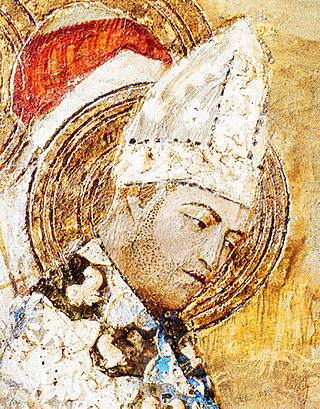
Pope Clement VI, born Pierre Roger, was head of the Catholic Church from 7 May 1342 to his death, in December 1352. He was the fourth Avignon pope. Clement reigned during the first visitation of the Black Death (1348–1350), during which he granted remission of sins to all who died of the plague.
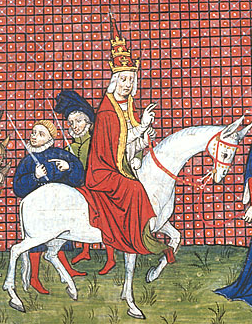
Pope Gregory XI was head of the Catholic Church from 30 December 1370 to his death, in March 1378. He was the seventh and last Avignon pope and the most recent French pope recognized by the modern Catholic Church. In 1377, Gregory XI returned the Papal court to Rome, ending nearly 70 years of papal residency in Avignon, France. His death was swiftly followed by the Western Schism involving two Avignon-based antipopes.
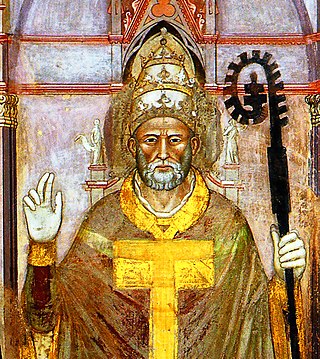
Pope Innocent VI, born Étienne Aubert, was head of the Catholic Church and ruler of the Papal States from 18 December 1352 to his death, in September 1362. He was the fifth Avignon pope and the only one with the pontifical name of "Innocent".

Pope John XXII, born Jacques Duèze, was head of the Catholic Church from 7 August 1316 to his death, in December 1334. He was the second and longest-reigning Avignon Pope, elected by the Conclave of Cardinals, which was assembled in Lyon. Like his predecessor, Clement V, Pope John centralized power and income in the Papacy and lived a princely life in Avignon.

The Avignon Papacy was the period from 1309 to 1376 during which seven successive popes resided in Avignon rather than in Rome. The situation arose from the conflict between the papacy and the French crown, culminating in the death of Pope Boniface VIII after his arrest and maltreatment by Philip IV of France. Following the subsequent death of Pope Benedict XI, Philip forced a deadlocked conclave to elect the French Clement V as pope in 1305. Clement refused to move to Rome, and in 1309 he moved his court to the papal enclave at Avignon, where it remained for the next 67 years. This absence from Rome is sometimes referred to as the "Babylonian captivity of the Papacy".

Pedro Martínez de Luna y Pérez de Gotor, known as el Papa Luna in Spanish and Pope Luna in English, was an Aragonese nobleman who, as Benedict XIII, is considered an antipope by the Catholic Church.
Pietro Colonna was an Italian cardinal.

The Diocese of Tarbes et Lourdes is a Latin Church ecclesiastical territory or diocese of the Catholic Church in France. Until 2002 Tarbes was a suffragan of the Archdiocese of Auch. It is now a suffragan of the Archdiocese of Toulouse.

Hélie de Talleyrand-Périgord was a French Cardinal, from one of the most aristocratic families in Périgord, south-west France. Hélie was born at Périgueux, third son of Elias VII, Count of Périgord, and Brunissende of Foix, daughter of Roger Bernard III, comte de Foix. His elder brothers were Archambaud (IV), who inherited the County, and Roger-Bernard ; his younger brother was Fortanier, and his sisters were Agnes, Jeanne, Marguerite, and Rosemburge. As a third son Hélie was destined for an ecclesiastical career. His brother, Roger Bernard, too, had an ecclesiastical career, becoming Canon of Lyon. But then, the eldest son died, and Roger-Bernard became the Count of Périgord. Hélie became a major figure in the Avignon papacy, and also a diplomat engaged in the negotiations of the Hundred Years' War, having friendships in both English and French royal families. In his last months he had been appointed Papal Legate for a crusade against the Turks.

The papal conclave held from 16 to 18 December 1352 was convened after the death of Pope Clement VI and elected as his successor Cardinal Etienne Aubert. The fifth pope of the period of the Avignon Papacy, he took the name Innocent VI. This conclave is remarkable because during its celebration cardinals for the first time in history subscribed the electoral capitulation, which limited the power of elect.

Arnaud de Pellegrue was a cardinal-nephew of Pope Clement V, the first pope of the Avignon Papacy.

The papal conclave held from 1 May 1314 to 7 August 1316 in the apostolic palace of Carpentras and then the Dominican house in Lyon was one of the longest conclaves in the history of the Roman Catholic Church and the first conclave of the Avignon Papacy. The length of the conclave was due to the division of the cardinals into three factions: Italian, Gascon, and French/Provençal.
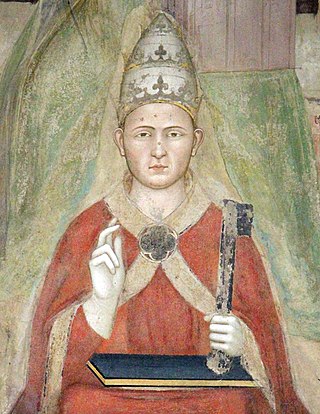
The 1304–1305 papal conclave was initiated after the death of Pope Benedict XI in July 1304. The conclave took place in Perugia, the city in which Benedict had died, and proved to be a protracted affair. It ran from 10 or 17 July 1304 to 5 June 1305, and ultimately elected the non-cardinal Raymond Bertrand de Got as Pope Clement V. At the time of his election de Got was Archbishop of Bordeaux, and thus a subject of Edward I, King of England, although he was a childhood friend of Philip IV of France. Clement V's decision to relocate the papacy to France was one of the most contested issues in the papal conclave following his 1314 death, during which the minority of Italian cardinals were unable to engineer the return of the papacy to Rome. This immediately preceded the beginning of the Avignon Papacy.

Napoleone Orsini was a Roman cardinal. His ecclesiastical career lasted 57 years, 54 of them as a cardinal, and included six conclaves.

Arnaud d'Aux was a relative of Pope Clement V, who named him bishop of Poitiers, and then cardinal-bishop of Albano. He accompanied cardinal Arnaud Nouvel in England in 1312. He acted also as Camerlengo of the Holy Roman Church from 1311 until 1319. He participated in the papal conclave, 1314-1316 and died at Avignon.
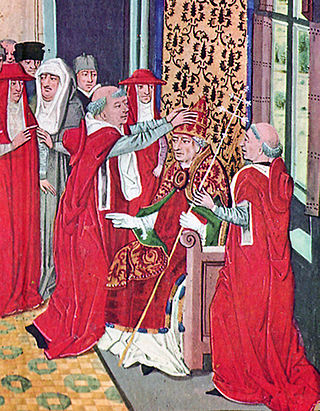
Guy of Boulogne was a statesman and cardinal who served the Avignon Papacy for 33 years. He participated in the papal conclaves of 1352, 1362 and 1370, and was the Subdean of the Sacred College of Cardinals. His diplomatic postings were extensive, including Hungary, Italy, and Spain. He headed an effort to end the Hundred Years' War. The historian Kenneth Setton called him "one of the commanding figures of his day, and the letters of Petrarch abound with references to him".
Giovanni Colonna was a Roman Catholic cardinal during the Avignon papacy and was a scion of the famous Colonna family that played an important role in Italian history.

Gaillard de La Mothe was a fourteenth-century prelate and Cardinal, of Gascon extraction. Gaillard was born towards the end of the 13th century, either in Toulouse or Bordeaux, and died in Avignon on 20 December 1356. He was the son of Amanieu Levieux de La Motte, seigneur of Roquetaillade. His mother was Elips (Alix) de Got, daughter of Arnaud-Garsale de Got, brother of Bertrand de Got. He was therefore a nephew of Pope Clement V. Gaillard had a brother, Bertrand. Another uncle, his father's brother, Guillaume de la Mothe, was Bishop of Bazas from 1303-1313, when he was transferred to Saintes, and again from 1318 to 1319.

Bernard d'Albi was a French cardinal of the 14th century. He was born at Saverdun in the diocese of Pamiers in the foothills of the Pyrenees, south of Toulouse and died on 23 November 1350 at Avignon.

Bertrand de Déaulx was a French bishop, diplomat, and Cardinal. He was born, perhaps around 1290, in Castrum de Blandiaco in the diocese of Uzès; or in Déaulx. He died in Avignon in 1355. Trained as a lawyer and teacher of law, he practiced in the papal courts and became an arbitrator and diplomat for the Papacy. He had several assignments in Italy and one in Catalonia. He was responsible for the reorganization of the University of Montpellier and the granting of revised charters.